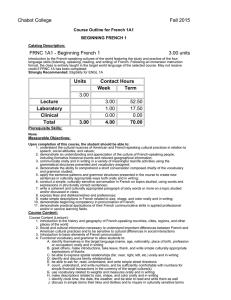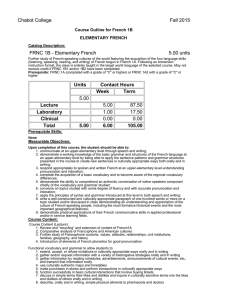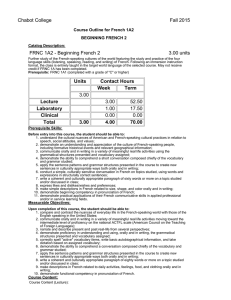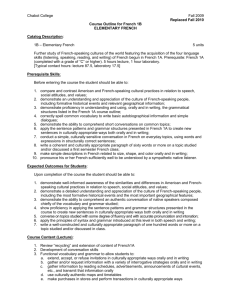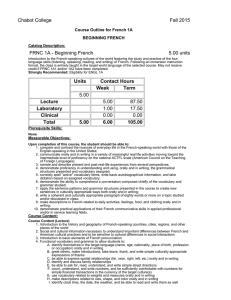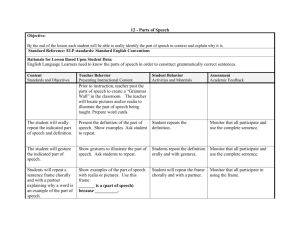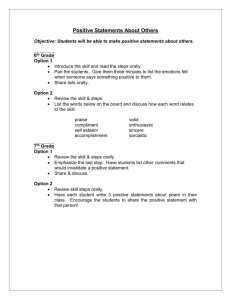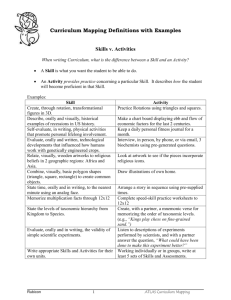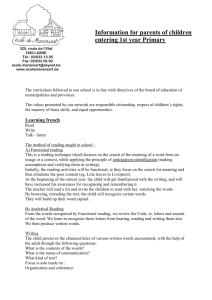Chabot College Fall 2015 FRNC 1B1 - Elementary French 1 3.00 units
advertisement
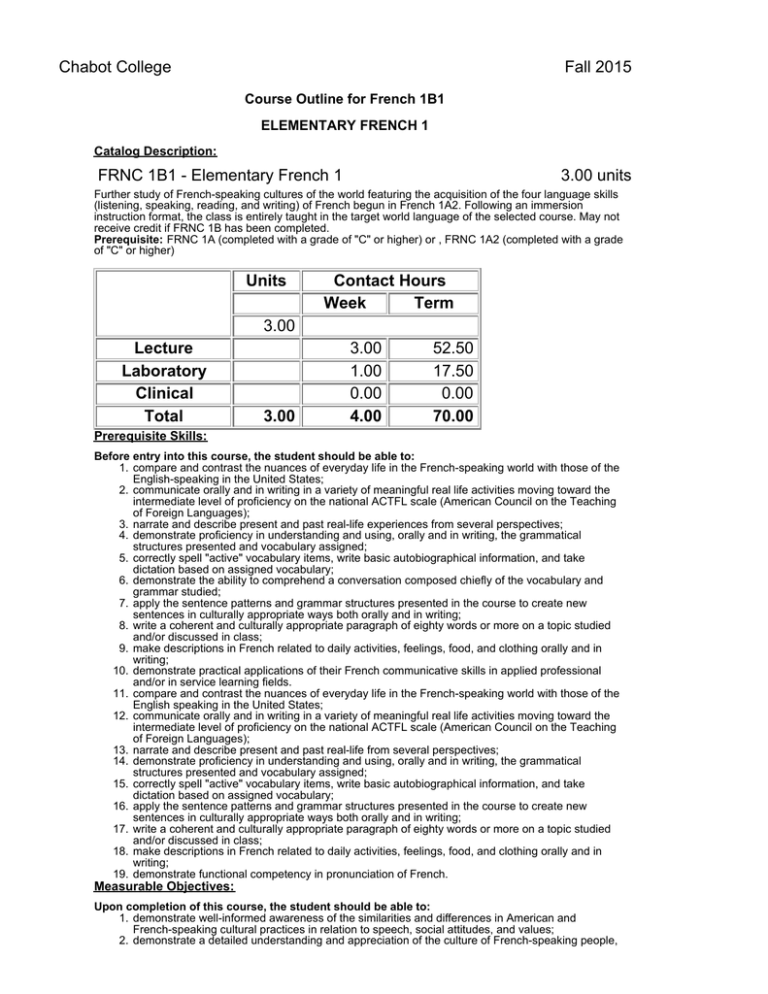
Chabot College Fall 2015 Course Outline for French 1B1 ELEMENTARY FRENCH 1 Catalog Description: FRNC 1B1 - Elementary French 1 3.00 units Further study of French-speaking cultures of the world featuring the acquisition of the four language skills (listening, speaking, reading, and writing) of French begun in French 1A2. Following an immersion instruction format, the class is entirely taught in the target world language of the selected course. May not receive credit if FRNC 1B has been completed. Prerequisite: FRNC 1A (completed with a grade of "C" or higher) or , FRNC 1A2 (completed with a grade of "C" or higher) Units Contact Hours Week Term 3.00 Lecture Laboratory Clinical Total 3.00 3.00 1.00 0.00 4.00 52.50 17.50 0.00 70.00 Prerequisite Skills: Before entry into this course, the student should be able to: 1. compare and contrast the nuances of everyday life in the French-speaking world with those of the English-speaking in the United States; 2. communicate orally and in writing in a variety of meaningful real life activities moving toward the intermediate level of proficiency on the national ACTFL scale (American Council on the Teaching of Foreign Languages); 3. narrate and describe present and past real-life experiences from several perspectives; 4. demonstrate proficiency in understanding and using, orally and in writing, the grammatical structures presented and vocabulary assigned; 5. correctly spell "active" vocabulary items, write basic autobiographical information, and take dictation based on assigned vocabulary; 6. demonstrate the ability to comprehend a conversation composed chiefly of the vocabulary and grammar studied; 7. apply the sentence patterns and grammar structures presented in the course to create new sentences in culturally appropriate ways both orally and in writing; 8. write a coherent and culturally appropriate paragraph of eighty words or more on a topic studied and/or discussed in class; 9. make descriptions in French related to daily activities, feelings, food, and clothing orally and in writing; 10. demonstrate practical applications of their French communicative skills in applied professional and/or in service learning fields. 11. compare and contrast the nuances of everyday life in the French-speaking world with those of the English speaking in the United States; 12. communicate orally and in writing in a variety of meaningful real life activities moving toward the intermediate level of proficiency on the national ACTFL scale (American Council on the Teaching of Foreign Languages); 13. narrate and describe present and past real-life from several perspectives; 14. demonstrate proficiency in understanding and using, orally and in writing, the grammatical structures presented and vocabulary assigned; 15. correctly spell "active" vocabulary items, write basic autobiographical information, and take dictation based on assigned vocabulary; 16. apply the sentence patterns and grammar structures presented in the course to create new sentences in culturally appropriate ways both orally and in writing; 17. write a coherent and culturally appropriate paragraph of eighty words or more on a topic studied and/or discussed in class; 18. make descriptions in French related to daily activities, feelings, food, and clothing orally and in writing; 19. demonstrate functional competency in pronunciation of French. Measurable Objectives: Upon completion of this course, the student should be able to: 1. demonstrate well-informed awareness of the similarities and differences in American and French-speaking cultural practices in relation to speech, social attitudes, and values; 2. demonstrate a detailed understanding and appreciation of the culture of French-speaking people, including the most formative historical events and the most important geographical features; 3. demonstrate the ability to comprehend an authentic conversation of native speakers composed chiefly of the vocabulary and grammar studied; 4. show proficiency in applying the sentence patterns and grammar structures presented in the course to create new sentences in culturally appropriate ways both orally and in writing; 5. converse on topics studied with some degree of fluency and with accurate pronunciation and intonation; 6. apply the principles of syntax and grammar introduced at this level in both speech and writing; 7. write a well-constructed and culturally appropriate paragraph of one hundred words or more on a topic studied and/or discussed in class; 8. demonstrate practical applications of their French communicative skills in applied professional and/or in service learning fields. Course Content: Course Content (Lecture): 1. Review and “recycling” and extension of content of French1A2 2. Comparative analysis of Francophone and American cultures 3. Further study of Francophone customs, values, attitudes, relationships, civil institutions, families, geography, and history 4. Continuation of the study of elements of French phonetics for good pronunciation Functional vocabulary and grammar to allow students to: 1. extend, accept, or refuse invitations in culturally appropriate ways orally and in writing 2. gather and/or request information with a variety of interrogative strategies orally and in writing 3. gather information by reading schedules, advertisements, announcements of cultural events, etc., and transmit that information orally 4. use culturally authentic maps and timetables 5. make purchases in stores and perform transactions in culturally appropriate ways 6. function successfully in basic cultural interactions that involve buying tickets 7. discuss in simple terms their likes and dislikes and inquire in culturally sensitive terms into the likes and dislikes of others orally and in writing 8. describe, orally and in writing, simple physical ailments to pharmacists and doctors 9. narrate simple events in past, present, and future orally and in writing 10. make physical descriptions of people and things orally and in writing 11. share information about events that have taken place 12. express frequency of actions and state how they are done 13. make recommendations and attempt to exert influence on others Syntax and grammar that allows students to correctly use orally and in writing: 1. The irregular verbes dire, lire, écrire, savoir, connaître, ouvrir, couvrir, découvrir, offrir, souffrir, vivre, suivre, conduire, construire, détruire, produire, réduire, and traduire 2. the imperfect, past perfect (plus-que-parfait), and future tenses of verbs 3. verb complements used with prepositions (the construction conjugated verb + preposition + infinitive) 4. the negative constructions ne… rien, ne… personne, rien… ne, and personne… ne 5. impersonal expressions followed by infinitives 6. the formation and placement of adverbs 7. the comparative and superlative forms of adjectives and adverbs 8. use of prepositions with geographical nouns 9. An introduction to French phonetics that includes accentuation, rhythm, linking (la liaison), and the schwa (l’e instable) The following cultural topics will be covered: 1. geography of the French-speaking world 2. history of French-speaking countries 3. Francophone music 4. Francophone art 5. Francophone literature 6. Francophone theatre 7. travel experience in French-speaking countries 8. the economy of French-speaking countries 9. the political systems of French-speaking countries Cultural Pluralism/Diversity Students will be exposed to a pluralistic and comparative approach to the study of the French language and Francophone civilization and culture. The learning of a language involves the study of the cultural values and other cultural factors that influence the language development. Consequently, this course fulfills the college’s goal of ensuring that students be exposed to cultural pluralism and diversity. Critical Thinking Students will be expected to learn the rules of grammar, pronunciation, and spelling. Throughout the learning of the language, a methodical and logical analysis of the rules and their exceptions is required in order to make appropriate grammar application. As communication, rather than a mastery of the rules in themselves, is the ultimate goal, a variety of assignments is given which illustrate the student’s ability to apply the material that he/she has learned. Course Content (Laboratory): 1. Activate lecture content using interactive audio and audiovisual programs on iLrn Motifs (online course content) Motifs iLrn passkey which includes access to: A. Motifs electronic Student Activities Manual (workbook + lab manual = homework) B. C. D. E. Textbook assignments (part of homework) Motifs eBook (online textbook) Video Library (part of homework) Enrichment- flashcards, web quizzes, games, glossary, Internet activities, Google Earth coordinates, interactive learning games, Heinle iRadio, grammar & vocab tutorials, verb conjugator F. Diagnostic exams with personalized learning plans 2. DVDs, CD ROMS, target language websites, etc., featuring culturally authentic and contextual guided speaking, reading, and writing activities such as cued repetition of native speech, dictations, cued oral responses, listening comprehension, and interactive realia (culturally authentic texts) 3. Organized laboratory activities including conversation groups 4. Fundamentals of French pronunciation: A. the consonant /R/ (all symbols between slashes are International Phonetic Alphabet symbols) B. The consonants /s/, /z/, /∫/, and /j/ (voiced /∫/) C. Aspirated and non-aspirated h D. The consonant /nj/ (spelled gn) E. The consonant /l/ (French light l contrasted to English light and heavy l’s) Methods of Presentation 1. 2. 3. 4. Lecture/Discussion Laboratory Group Activities Class and group discussions Assignments and Methods of Evaluating Student Progress 1. Typical Assignments A. Critical Writing assignment: after studying the aspect of the action reported by verbs in the past tense and the narrative components of a fairy-tale in French write your own version of a fairy-tale, fable, or traditional story using the preterit and the imperfect. The actions include a beginning, a middle or progression, and an end of the story. B. Oral assignment: prepare a skit in which one person accepts an invitation and the other declines an invitation; both use culturally appropriate expressions. C. Cultural Writing Assignment: Prepare a travel itinerary to five different French-speaking areas on three different continents to demonstrate proper use of prepositions with numerous geographical names. D. Laboratory Assignment: After studying linking and the silent e in French pronunciation, make a recording of poem. 2. Methods of Evaluating Student Progress A. Exams/Tests B. Quizzes C. Class Participation D. Homework E. Final Examination F. Lab Activities G. Oral Presentation H. Papers Textbook (Typical): 1. K. Jansman, and M. A. Kassen (2014). Motifs-An Introduction to French (6th ed./e). Heinle Cengage Learning. Special Student Materials 1. none
